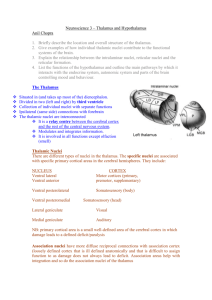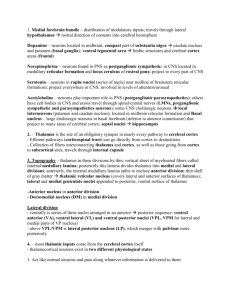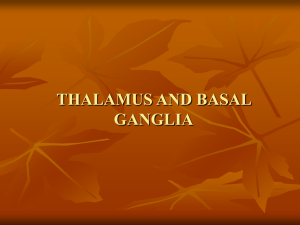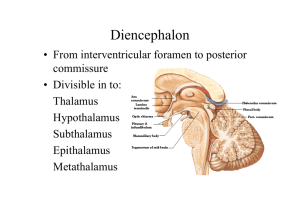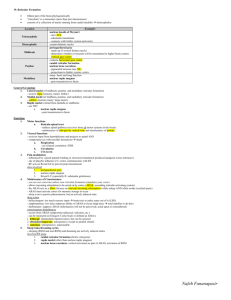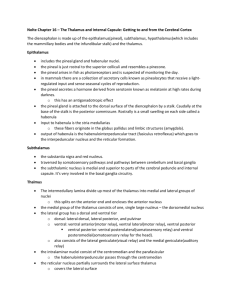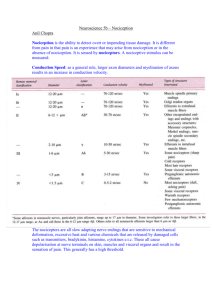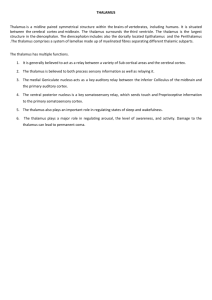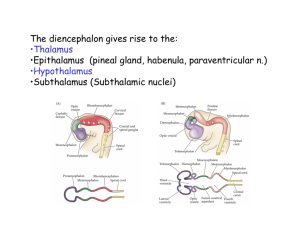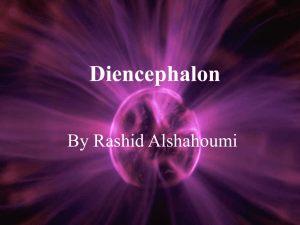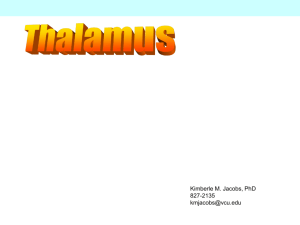Overview of the Reticular Formation (RF)
advertisement
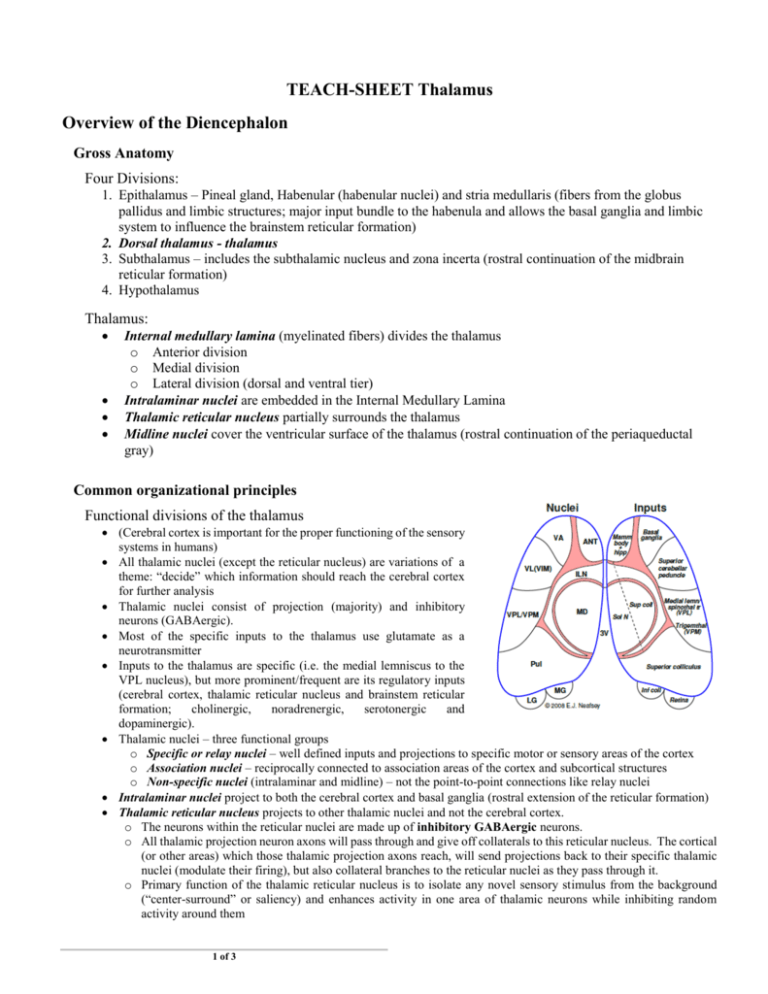
TEACH-SHEET Thalamus Overview of the Diencephalon Gross Anatomy Four Divisions: 1. Epithalamus – Pineal gland, Habenular (habenular nuclei) and stria medullaris (fibers from the globus pallidus and limbic structures; major input bundle to the habenula and allows the basal ganglia and limbic system to influence the brainstem reticular formation) 2. Dorsal thalamus - thalamus 3. Subthalamus – includes the subthalamic nucleus and zona incerta (rostral continuation of the midbrain reticular formation) 4. Hypothalamus Thalamus: Internal medullary lamina (myelinated fibers) divides the thalamus o Anterior division o Medial division o Lateral division (dorsal and ventral tier) Intralaminar nuclei are embedded in the Internal Medullary Lamina Thalamic reticular nucleus partially surrounds the thalamus Midline nuclei cover the ventricular surface of the thalamus (rostral continuation of the periaqueductal gray) Common organizational principles Functional divisions of the thalamus (Cerebral cortex is important for the proper functioning of the sensory systems in humans) All thalamic nuclei (except the reticular nucleus) are variations of a theme: “decide” which information should reach the cerebral cortex for further analysis Thalamic nuclei consist of projection (majority) and inhibitory neurons (GABAergic). Most of the specific inputs to the thalamus use glutamate as a neurotransmitter Inputs to the thalamus are specific (i.e. the medial lemniscus to the VPL nucleus), but more prominent/frequent are its regulatory inputs (cerebral cortex, thalamic reticular nucleus and brainstem reticular formation; cholinergic, noradrenergic, serotonergic and dopaminergic). Thalamic nuclei – three functional groups o Specific or relay nuclei – well defined inputs and projections to specific motor or sensory areas of the cortex o Association nuclei – reciprocally connected to association areas of the cortex and subcortical structures o Non-specific nuclei (intralaminar and midline) – not the point-to-point connections like relay nuclei Intralaminar nuclei project to both the cerebral cortex and basal ganglia (rostral extension of the reticular formation) Thalamic reticular nucleus projects to other thalamic nuclei and not the cerebral cortex. o The neurons within the reticular nuclei are made up of inhibitory GABAergic neurons. o All thalamic projection neuron axons will pass through and give off collaterals to this reticular nucleus. The cortical (or other areas) which those thalamic projection axons reach, will send projections back to their specific thalamic nuclei (modulate their firing), but also collateral branches to the reticular nuclei as they pass through it. o Primary function of the thalamic reticular nucleus is to isolate any novel sensory stimulus from the background (“center-surround” or saliency) and enhances activity in one area of thalamic neurons while inhibiting random activity around them 1 of 3 Interconnections between thalamus and cerebral cortex and subcortical structures travel through the internal capsule Anterior – passes through the anterior limb of the internal capsule to reach the prefrontal and cingulate gyrus Superior – Passes through the posterior limb of the internal capsule to reach the premotor, motor and somatic sensory cortex Posterior – passes through the retrolenticular part of the internal capsule to reach the occipital lobes, posterior parietal and temporal Inferior – passes through the sublenticular part of the capsule, below the lentiform nucleus to reach the anterior temporal and orbital cortex Neuroanatomical “Roadmaps” (Anterior division, medial division, lateral division;*ventral tier) Type Specific (or relay) Nucleus Afferents Efferents Anterior Mammillary body, hippocampus Cingulate gyrus *Ventral anterior (VA) Basal ganglia (substantia nigra; pars reticulata) Prefrontal cortex *Ventral lateral (VL) - anterior part Basal ganglia (globus pallidus, internal) Supplementary motor area *Ventral lateral (VL) - posterior part Cerebellar nuclei Premotor & Motor cortex *Ventral posteromedial (VPM) Somatic afferents from the head region Somatic sensory cortex *Ventral posterolateral (VPL) Somatic afferents from trunk and limbs Somatic sensory cortex *Medial geniculate body Brachium of the inferior colliculus Primary auditory cortex *Lateral geniculate body Optic tract & (Superior colliculus?) Primary visual cortex Lateral dorsal (LD) Hippocampus Cingulate cortex Superior colliculus, primary visual, auditory and somatosensory cortex Posterior parietal and lateral temporal association cortex Dorsomedial (DM) (or Mediodorsal) Prefrontal cortex, olfactory, limbic Prefrontal cortex Intralaminar (centromedian, parafascicular, others) Reticular formation, basal ganglia and limbic system Cerebral cortex, basal ganglia and limbic system Reticular Thalamus and cortex Thalamus Lateral posterior (LP) Association Non-specific Pulvinar 2 of 3 Dorsomedial Some clinical correlates Thalamic pain o Following a stroke (usually) which damages the ventral posterior nucleus there is a period of contralateral loss of sensation followed by severe pain, spontaneous or in response to tactile stimuli Thalamic syndrome o Injury to the posterior thalamus can result in the loss of contralateral somatic sensation, spinothalamic as well as medial lemniscal modalities. The thalamic syndrome is the constellation of thalamic pain, hemisensory loss and sensory ataxia, contralateral to a posterior thalamic lesion. Vascular supply of the thalamus & internal capsule Small branches of the middle cerebral artery (lenticulostriate arteries – lateral striate), anterior cerebral artery (recurrent artery of Heubner (medial striate artery) and the anterior choroidal artery provide most of the blood supply to the internal capsule Small branches of the posterior cerebral artery provide most of the blood supply to the thalamus 3 of 3
